A City Divided: Understanding segregation in San Francisco
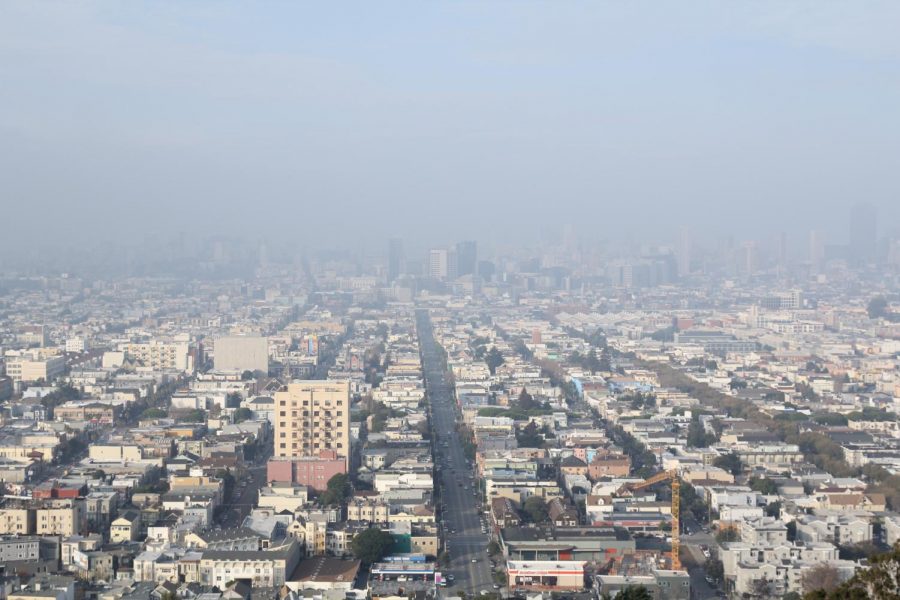
The view from Bernal Heights Park overlooks San Francisco.
Lowell students come from all over the city–from the Mission with its colorful murals, to the Sunset with its foggy beaches, to Noe Valley with its quaint cafes. But while San Francisco’s distinct neighborhoods provide personality and culture, underneath lurks a more sinister issue: segregation. We typically think of segregation as a phenomenon of the past, but this isn’t the case. While our neighborhoods are no longer segregated by law, ethnic concentrations are still very much present, and have a very real impact on the way people within different communities live.
Because students come from different places and situations, there can be a disparity in the opportunities they get and the resources they have access to. From the schools they attend, to their income status, to their neighborhood communities, there are a lot of factors that affect a student’s personal and educational experience.
Although San Francisco is a politically liberal city, it’s still significantly racially segregated. Neighborhood separation by race affects wealth distribution, educational opportunities, access to resources and a variety of other factors.
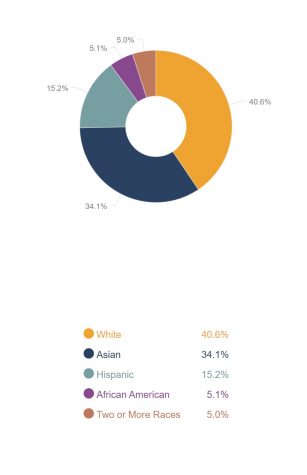
San Francisco Ethnic Breakdown. Data from U.S. Census Bureau
The ethnic makeup of individual neighborhoods typically varies significantly from the makeup of San Francisco in general. If each neighborhood was reflective of the population of the city, it would be around 41 percent white, 35 percent Asian, 15 percent Hispanic and 5 percent African American, according to the United States Census Bureau. This is almost never the case.
Wealth disparity in San Francisco varies drastically by race. The overall poverty rate in San Francisco is around 13 percent, but for African Americans it’s 32 percent, and for whites only 8 percent, according to World Population Review. The poverty rate for Asians is 13 percent and 15 percent for Hispanics.
A recent UC Berkeley study examined possible causes for concentrations of poverty and segregation in the Bay Area. According to Miriam Zuk, co-author of the study, they found a significant increase in the number of segregated neighborhoods with a large proportion of households living in poverty, as well as an overrepresentation of certain ethnic groups.
The study found a correlation between these segregated neighborhoods and a rise in housing prices and rent, as well as a shift in where low-income people of color lived during the study, which lasted from 2000 to 2015. This phenomenon can have fairly devastating effects, according to Zuk. “I think in general we found historically that concentrating low-income households in specific neighborhoods without resourcing those neighborhoods is not a good thing,” she said. “It can be pretty damaging to children and their opportunity set.”
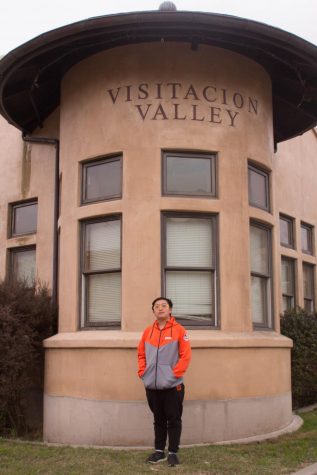
Tarsa Yuen frequents the Visitation Valley branch library.
These differences in income and ethnicity can play a large role in the school system, especially in elementary and middle schools, according to former AP Human Geography and current AP Economics teacher Rebecca Johnson. Schools from disparate neighborhoods have varying amounts of funding, parent involvement and pressure to perform well. “You’ve got this kind of clustering of schools that are supposed to be feeding into Lowell, but based on the education those kids are receiving, some of them don’t feel as prepared,” she said.
Kathleen Coll, a politics professor at the University of San Francisco, believes that changing the district assignment policy and lifting the cap on racial groups has led to an increase in racial isolation among schools. “The way that residential segregation has played out historically and continues today creates challenges for having neighborhood schools that are not racially isolated and have equal quality and equal amount of resources,” she said.
Coll sees that segregation has become more normalized in the city. “There’s a certain sector of the city that believes that economic change and population change is an inevitable part of urban life, and there’s others for whom it’s a priority to try to maintain racial and economic diversity and to avoid forced displacement,” she said.
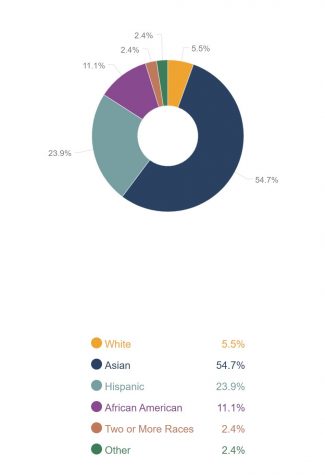
Visitation Valley Ethnic Breakdown
Many students don’t think of ethnic concentration as a significant issue, even though they recognize that their neighborhoods may disproportionately reflect a certain ethnicity. Sophomore Tarsa Yuen lives in Visitacion Valley, a neighborhood he says is portrayed as “part of that area you want to avoid.” He regards it as fairly unsafe. “In general in the neighborhood you do have to be a lot more careful,” Yuen said, “because there’s a lot of sketchy people and violence in the streets and sometimes you’ll hear gunshots being fired.” He also stated that, by and large, Visitacion Valley is populated by poor people of color. According to the U.S. Census Bureau, less than 6 percent of Visitacion Valley’s population is white, with 54 percent being Asian, 23 percent Hispanic, and 11 percent African American. It’s also one of the poorest neighborhoods in the city, with a median income of $55,600, according to Statistical Atlas.
Because they face a lot of the same issues, people who live in his neighborhood have formed more of a cohesive culture, according to Yuen. “They know that this area is labelled as bad, they know that the schools are labelled as terrible, as dangerous, as sketchy. And they know that the people are also labelled as drug dealers, or drug users, or outcasts, people that have gone to prison, all sorts of these people,” Yuen said. “But slowly people are starting to band together in a community.” Yuen sees this in a decreasing amount of violence and polarization between African Americans and Asians in his neighborhood.
Yuen attended a middle school close to his home–Visitacion Valley Middle School. Minority enrollment at Visitacion Valley Middle School is 98 percent, according to Public School Review. It placed in the bottom 50 percent of test scores for all of California, with a math proficiency of 11 percent and language arts proficiency of 15 percent, lower than the respective averages of 37 percent and 48 percent for 2015-16. “It definitely does not feel super safe,” he said. “It can get kinda loud sometimes, or physical, so it kind of disrupts a lot.”
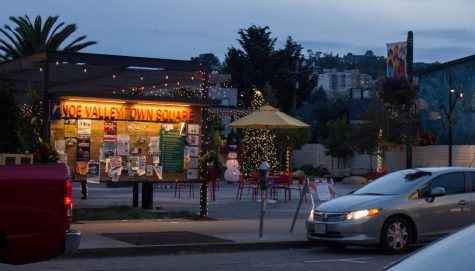
Noe Valley’s population is 72 percent white,
whereas the whole of San Francisco is only 40
percent white.
Once, Yuen’s school was put on lockdown because of an active shooter in the area. “We were just playing basketball and I don’t remember what happened, someone got shot and we just went on lockdown all of a sudden; we did not know what was happening,” Yuen said. He later found out that someone had been shot at a nearby park.
Many of Yuen’s peers struggled, but he doesn’t believe the school itself is at fault. “For a lot of those courses it mainly depends if you wanna put the effort towards succeeding academically,” he said, “and those people didn’t want to put that effort forward so they just didn’t do that great.” Yuen says the school was underfunded, but was lucky because it received donations from big companies such as Salesforce.
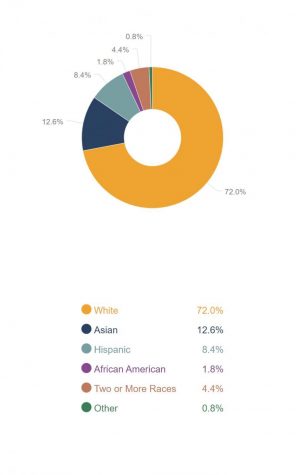
Noe Valley Ethnic Breakdown
Out of around 150 students in his graduating class, Yuen was one of 12 that went to Lowell. Yuen felt that while he was fairly well prepared for Lowell because of the effort he put in, many others in his class weren’t prepared for high school at all.
Yuen thinks that segregation is an issue in San Francisco, and one that is normalized, specifically with socioeconomic status. “It’s not segregation like it used to be with race but it’s more of a classist segregation,” he said.
In contrast to Yuen’s neighborhood, Freshman Fiona Morgan lives in Noe Valley, a neighborhood she says is safe and nice to walk around in. “It’s really calm there, there’s lots of families that live there, so you just walk around and see families,” Morgan said. “It’s a really nice neighborhood.” Her neighborhood has a variety of educational opportunities, such as public libraries and tutoring.
Noe Valley is 72 percent white, according to the U.S. Census Bureau. The second largest demographic group is Asian with 12 percent, then Hispanic with eight percent and African American with less than two percent. It also has a higher than average median income, with over 65 percent of households making over $100,000.
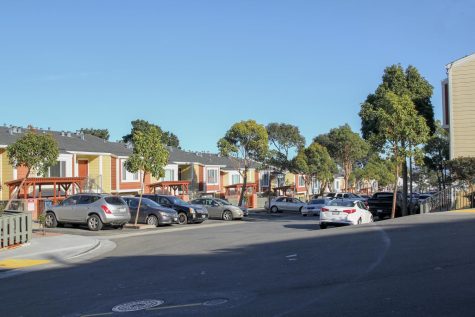
The average income in Hunters Point is $32,000, much lower than that of the average San Francisco resident.
Morgan sees her neighborhood as pretty representative of the general population. She doesn’t think that segregation is a current issue faced by San Francisco.
Halfway across the city, junior Darius Heckard lives in West Point, a predominately African American neighborhood located within Hunters Point. Hunters Point is 53 percent African American, 16 percent Hispanic, 9 percent Asian and 8 percent white, according to the U.S. Census Bureau. Hunters Point is significantly less wealthy than the general San Francisco population, with a median income of $32,000, as compared to $88,000.
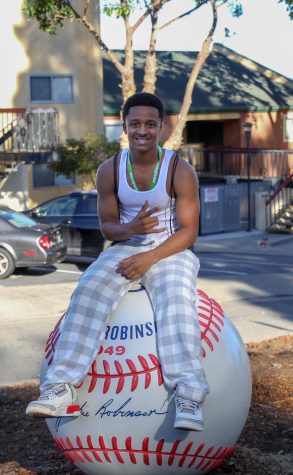
Darius Heckard sits atop a sculptural tribute to Jackie Robinson, the first African American to play in Major League Baseball.
Heckard likes where he lives. “It’s not the perfect neighborhood, but it’s my neighborhood,” he said. “I love where I’m from. I feel we’re all pretty rich, not like wealth-wise, but through other stuff. For us, we don’t really consider money wealth.”
Most people in his neighborhood work, according to Heckard, and he himself helps pay his family’s bills. “I help my mom with rent, and I’m pretty sure my friends help their parents with rent,” Heckard said.
West Point used to experience more violence, but in recent years it’s decreased, according to Heckard. “In my community we were just tired of all the violence that had been happening so we all came to some sort of an agreement to stop,” he said. Heckard thinks of his neighborhood community as a kind of family. “I know everyone on the block, and the next block,” he said. “We all pretty close. We’re more about family and community and having each others’ backs.”
Heckard normally drives to Lowell, but before he had a car it was a much more of a trek. It takes three buses and an 120 minute commute to get to Lowell everyday. Apart from school, Heckard spends most of his time in West Point. “I don’t pay attention to most neighborhoods outside of my own,” he said.
Heckard notices segregation in his own neighborhood. “Segregation is a problem,” he said. “I see it all the time.”
Sophomore Alexander Shketav lives in the Mission, on Liberty Street near Dolores Park. Shketav characterizes his neighborhood as “full of random middle-class people [who] work simple jobs,” and relatively lacking in a homeless population compared to other parts of the city. He says that the residents of the neighborhood generally treat each other well, but also recalls the ostracization of certain individuals who defy the community’s requests. He thinks his neighborhood is usually safe, “other than the occasional crazy person roaming the streets.”
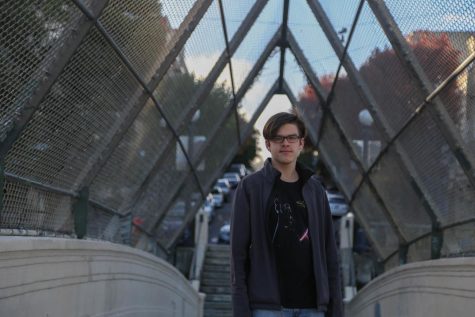
Alexander Shketav stands on a bridge next to Dolores Park. The bridge marks a cultural divide between the neighborhood’s inhabitants.
The average household income in the Dolores Park area is $131,000, about 50 percent higher than the San Francisco average of $88,000, and it is 73 percent white, 9 percent Hispanic, 12 percent Asian and 2 percent African American.
Shketav believes that San Francisco is somewhat segregated. “Although I do not pay attention much to see if there is segregation, I am sure that there is some,” Shketav said. “In the past, there may have been segregation, and that would have set the area to be segregated.”
Senior Chloe Kerr-Stein also lives in the Mission–but in a very different neighborhood. Kerr-Stein’s part of the Mission is 43 percent white, 35 percent Hispanic, 14 percent Asian, and four percent African American. The median household income is $97,000, but varies greatly between different tracts of the neighborhood. “There’s two cultures,” she said. “On my side of the street, we’re on rent control. Literally across the street there’s an apartment building with million dollar apartments.”
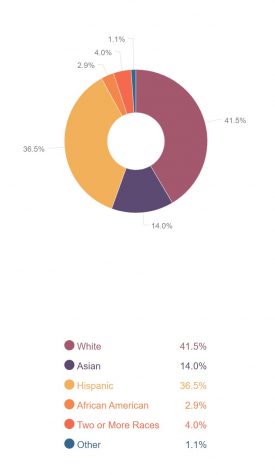
Mission District Ethnic Breakdown
Kerr-Stein believes a big reason for this divide is gentrification. “It’s basically the wealthy side kicking out the not as wealthy side,” she said. Kerr-Stein has experienced this since she was a kid–stores changing, families leaving. “I’ll see store fronts, like this bookstore I’ve been to since I was a kid, and now it’s all boarded up and several months later it’s this really really fancy store,” she said.
Kerr-Stein has lived in her part of the Mission since she was nine. Before that she lived on the outskirts of the neighborhood, near Noe Valley, which she said was much safer and family-oriented. “There’s Mission Street and then the more blocks up you go towards Church the nicer it gets,” she said.
While she loves the culture of her neighborhood, there are certain issues that come with living in her part of the city. Homelessness is a big one; Kerr-Stein has seen the same people on the streets for years. “Things just aren’t getting better and that’s really sad,” she said.
As Kerr-Stein grew up, her family moved further and further into the heart of the Mission. The first time they moved, their landlord paid them to leave in order to renovate the building and sell or rent it at a higher price, as it was legal for them to do so, according to Kerr-Stein. The same thing happened with her next home in Fair Oaks, but the most recent move was for a different reason. “My dad found a place that he liked more, and also he needed a storefront for his shop,” Kerr-Stein explained.
Kerr-Stein went to Creative Arts Charter School, a K-8 school located on Turk Street that she described as “very white, very artsy and hippie, not hipster.” Creative Arts is an alternative school with a more arts based curriculum, which, according to Kerr-Stein, attracted students with quirky parents or who were a little quirky themselves. “It was all of this lint collected from all the different weird corners, like all the people who didn’t belong all being pushed together, and that was the student body.”
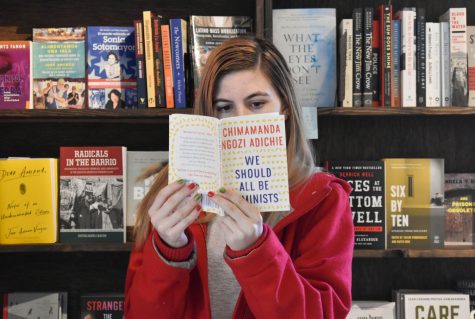
Kerr-Stein reads in Manny’s Cafe, a hub of political activism.
Out of her class of 50 students, 6 went to Lowell. Kerr-Stein said the school didn’t prepare her academically, but because she likes learning and does all her work she can handle the workload.
Kerr-Stein does see segregation as an issue that’s becoming normalized in San Francisco. “Most neighborhoods are mostly one race,” she said. “I think it’s mostly self-segregation, though.”
San Francisco is a lot more complicated than it may seem, and so is segregation. The nuance and intersectionality of the issue makes finding a straightforward solution difficult. Zuk believes policy makers and the general public need to be made aware of this issue in order to “create a public will to make change.” Segregation also ties back to fixing the school system, she said. “If we don’t integrate our neighborhoods we won’t integrate our schools, and it seems like we’re heading on the wrong trajectory on both counts.”

Kerr-Stein stands in front of one of the many murals in the Mission District.
Coll suggests public, rental, low-income and federal housing as “policies and programs that would prevent people from racial isolation in neighborhoods and would probably help slow the process of segregation.”
While many people don’t seem phased by an increase in segregation in San Francisco’s neighborhoods, a lot of residents are actively working towards solving this issue, according to Coll. “That’s the source of a lot of community activism which has very effectively slowed things like mass eviction,” she said. “They believe that housing is not just a commodity that should be subject to the whims of the unregulated market and that there’s major consequences for the city, that it becomes racially and economically and socially polarized and segregated.”
The mere existence of ethnic concentrations within neighborhoods is not inherently bad. “San Francisco has a long history of ethnic neighborhoods,” Coll said. “The existence of those neighborhoods is not a problem unless those neighborhoods are prevented from having equal access to public goods and services.”
Yuen believes that in order for segregation to be addressed, an attitudinal shift needs to take place. “Most citizens of the city want to keep away from people who come from places they see as dangerous, typically low income neighborhoods,” Yuen said. “If we started accepting these people and integrated them into our society, we may see less of these struggling neighborhoods.”
Reporter Lee Wilcox contributed to this article.
Additional information
There are multiple causes for ethnic concentration. The most common is chain migration, a phenomenon that has received a lot of attention in recent years, according to Johnson. Migrating to a new country can be a difficult experience, one made easier by having others from your home country nearby, so immigrants from the same country tend to concentrate in the same areas. Other common causes are covenants (neighborhood agreements that sometimes occur on racial terms), and zoning laws that discourage large families. These disproportionately affect people of color and especially immigrants, who often have large families, according to Johnson.
Another big reason for the uneven distribution of ethnicities is redlining, the infamous real estate practice that is no longer done, but whose effects linger. Essentially, banks would “redline”, or avoid giving loans to certain neighborhoods, typically those with a larger concentration of minorities. This made it much harder for those residents to buy housing and often meant that they couldn’t afford to move to ‘nicer’ neighborhoods.
This can allow people who have never seen another culture an opportunity to interact with it, but it can also result in uneven distribution of population, concentration of poverty and crime, and is often self-reinforcing, according to Johnson.
“When you can’t live in [wealthier neighborhoods] because of a covenant, and you can’t get a loan for you own neighborhood due to redlining, it perpetuates wealth inequalities,” Johnson said. “It’s gonna be a self-fulfilling prophecy in terms of negative neighborhoods.”

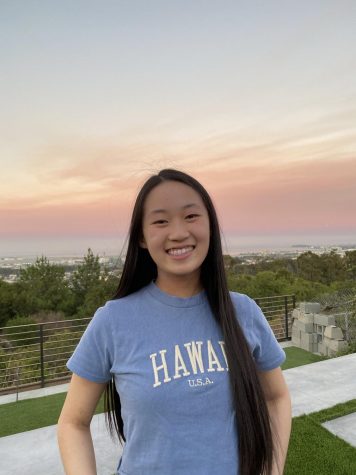
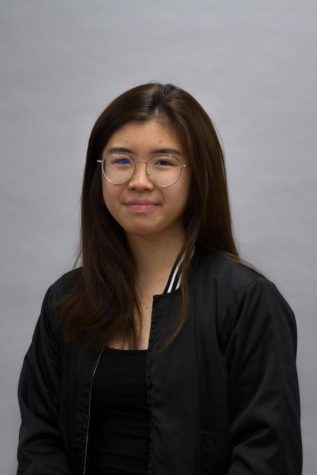
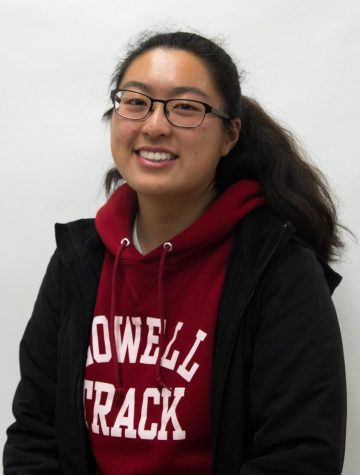
Find me taking photos, pole vaulting, and avoiding sand :)


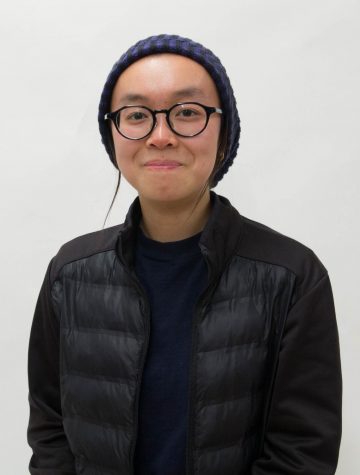

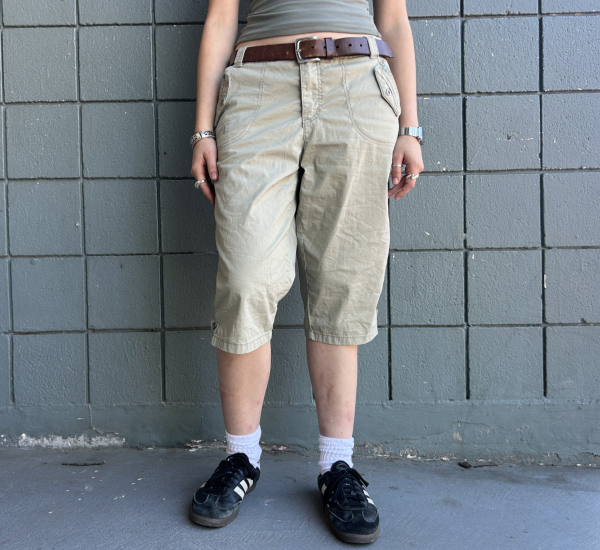

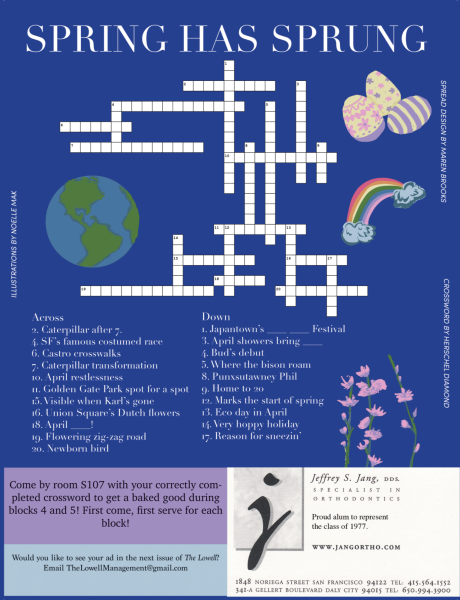
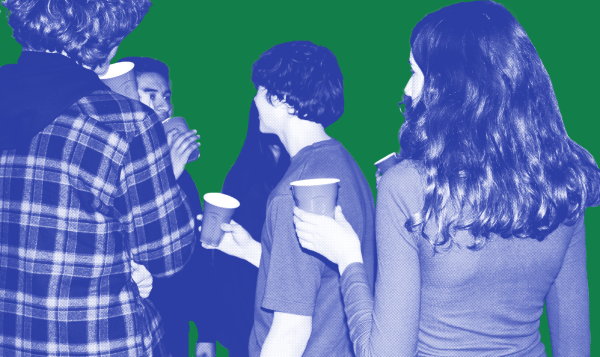




Whittaker • Feb 6, 2020 at 1:53 pm
Hello! I am a teacher in SFUSD. I assigned your article to my students. Thanks for writing such an informative piece. Lots of great information! Well done.
Matthew Porter • Jan 24, 2019 at 9:43 am
Great article. When I emigrated to the USA in 1974 the first neighborhood I lived in was Noe Valley. After that we moved to Forest Hill.
I roamed the city by bus and streetcar for hours at a time and marveled at the hundreds of different neighborhoods.
At Lowell I had friends from all over the city.
The fact is that the city, although generally diverse, does have “enclaves”…
Again, great article.